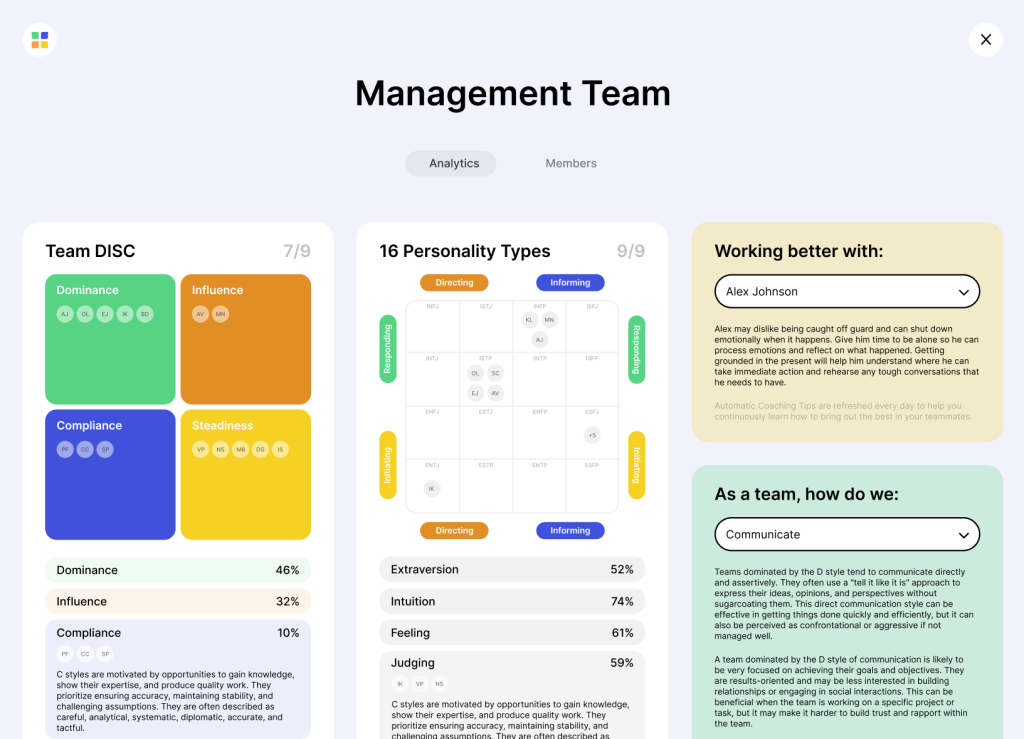The Enneagram is a fascinating model of the human psyche, which is primarily understood and taught as a typology of nine interconnected personality types.
It’s common to identify strongly with one of the types – your core type – which seemingly dictates various facets of your behavior, strengths, and weaknesses.
But can this core type shift as we journey through the landscapes of our lives? This question invites us to explore the fluidity of our personal development and the impact of life experiences on our intrinsic Enneagram type.
This article will delve into this question and explore whether our Enneagram type can change over time.
How Does the Enneagram System Work?
The Enneagram system is a model of human psychology comprising nine interconnected personality types.
A specific set of core beliefs, underlying motivations, and typical behavior patterns define each type. The nine types are conventionally numbered from One to Nine and are arranged around the Enneagram symbol – a geometric figure that maps out the connections between the different types.
The Nine Enneagram Types
The 9 types are as follows:
- Type One: The Reformer – driven to be good and upright.
- Type Two: The Helper – acts from a need to be loved and appreciated.
- Type Three: The Achiever – success-oriented, values accomplishment.
- Type Four: The Individualist – desires identity and significance.
- Type Five: The Investigator – seeks understanding and knowledge.
- Type Six: The Loyalist – driven by the need for security and support.
- Type Seven: The Enthusiast – pursues freedom and happiness.
- Type Eight: The Challenger – seeks control and self-reliance.
- Type Nine: The Peacemaker – desires inner stability and peace of mind.
Core Beliefs and Motivations
Each Enneagram type has distinctive core beliefs that guide their perception of the world and influence their behavior. These beliefs form during childhood and are an unconscious framework for coping with one’s environment.
For example, a Type One might believe that it is only through perfection that one can avoid criticism, whereas a Type Six might believe that without support and guidance, one cannot face life’s challenges.
Motivations are an extension of these beliefs – the deep-seated whys behind a person’s actions. Understanding these motivations can be enlightening, as it clarifies why individuals react differently to the same situation.
Behaviors and Adaptive Patterns
The behaviors of each Enneagram type are expressions of their core beliefs and motivations.
These can manifest as adaptive or maladaptive patterns, where adaptive behaviors effectively foster well-being and success in life, and maladaptive behaviors might serve as defense mechanisms that ultimately cause challenges.
A Type Three may adaptively pursue career success but might maladaptively become overly image-conscious or deceitful to maintain a façade of success.
Through awareness of these patterns, individuals can consciously work towards personal development and healthier coping strategies.
The Role of Personal Growth
Understanding your Enneagram type is not a matter of putting oneself in a box but rather a starting point for growth.
As individuals become more aware of their Enneagram type, they can notice their automatic responses to stress, recognize their strengths and weaknesses, and consciously make choices that align with their values beyond their conditioned responses.
Delving into one’s Enneagram type encourages self-exploration. It can be a transformative process, leading an individual down a path of self-improvement and helping them to break free from limiting patterns.
Enneagram Wings Explained
Enneagram wings are the types adjacent to an individual’s primary Enneagram type that provide secondary influences on their personality.
While a person’s core type is the most telling of their intrinsic motivations and worldview, the wings add complex layers, refining and sometimes countering their core behaviors and beliefs.
Think of wings as nuances that can accentuate or balance certain aspects of an individual’s personality. They are deemed ‘wings’ because they are thought to be the two types on either side of your primary type, potentially helping you to ‘fly’ with a more comprehensive understanding of yourself.
How Wings Modify Core Characteristics
The role of wings is critical in modifying the core characteristics of the Enneagram type. They contribute additional strengths, challenges, and tendencies that influence how traits of the core type are expressed.
Imagine a Type Eight, known for being decisive and willful; having a Nine wing might smooth out the Eight’s assertiveness with a more amiable and cooperative demeanor.
Conversely, a Seven wing could enhance their spontaneity and adventurous spirit.
The wings bring a dynamic element to the personality, ensuring no single type is one-dimensional.
The Concept of Dominant and Less Dominant Wings
Everyone can access both wings to some extent, but typically, one wing is more dominant. This dominant wing significantly colors one’s personality profile, often more evident in behaviors, coping strategies, and attitudes.
For instance, a Type Two with a more substantial Three wing may be more success-oriented and image-conscious than a Type Two with a more dominant One wing, who might be more perfectionistic and idealistic.
This dominance is not fixed; under different circumstances or during various life stages, the less dominant wing can come to the forefront.
Impact of Wings on Personal Growth
Understanding one’s wings is crucial for personal growth, as it allows for a deeper exploration of the self.
By recognizing the influences of their wings, individuals can start to see the range of behaviors they exhibit and learn to tap into the strengths of both wings as needed consciously.
It’s like having a toolkit; sometimes, a situation calls for the assertiveness of an Eight, and at other times, the peacemaking of a Nine.
Engaging with the wings encourages individuals to develop a more balanced approach to their personal and professional lives, broadening their growth potential.
Wings Interaction with Stress and Security Points
The interaction between wings and the core type also extends to how an individual experiences stress and security.
The Enneagram teaches that individuals move toward different types in times of growth or stress, and wings can influence the direction and expression of these movements.
A core type under stress might exhibit less healthy characteristics of its wings or might draw on the strengths of its wings to better manage stressors.
Similarly, in times of security or growth, an individual might adopt more of the positive aspects of either wing, aiding in their progression toward integration and balance.
Can Your Enneagram Type Change?
It’s a common misconception that one’s Enneagram type can shift or change throughout life.
However, the core Enneagram type is believed to remain consistent, rooted in one’s early childhood experiences and around a specific core belief that shapes the individual’s worldview.
This core type shapes an individual’s primary motivation and fears and does not alter. Nevertheless, the expression of this type through behaviors and attitudes can vary significantly, which may give the impression of a change in type.
Growth and Stress Paths
The Enneagram framework describes distinct growth and stress paths for each type, often called integration and disintegration.
In periods of growth or integration, an individual is said to exhibit the healthier traits of another kind that their type connects with.
For example, a Type Three might begin showing traits of a healthy Type Six: valuing cooperation and becoming more internally motivated by trust. Conversely, during stress or disintegration, a person may display the more negative traits of another specific type.
That same Type Three might resemble an unhealthy Type Nine, becoming disengaged and complacent.
Perceived Type Changes
The perception of a type of change often originates from substantial personal development or life-changing events. As people mature or navigate the highs and lows of life, different facets of their personality come forward.
These changes don’t signify a switch in Enneagram type but rather the dynamic nature of personality and the fluid movement along the paths of growth and stress within the Enneagram framework.
The Role of Wings and Instinctual Variants
Wings and instinctual variants can also contribute to the appearance of a type change. A person’s dominant wing can become more prominent, or a less dominant wing can surface, altering how certain traits are expressed.
Similarly, shifts in the balance of one’s instinctual variants (self-preservation, social, or one-to-one) can also result in behavior changes that might seem like a change in the core Enneagram type.
Integrating the Whole Enneagram Spectrum
Understanding the Enneagram’s full spectrum, including one’s type, wings, growth paths, and stress paths, allows for recognition of the innate stability of one’s type while also validating the complexity of personal development.
Growth within the Enneagram does not mean changing who one is at the core; instead, it entails integrating characteristics from across the spectrum to create a more well-rounded and healthier expression of one’s primary type.
Can Your Enneagram Wing Change?
The concept that an individual’s dominant Enneagram wing can shift over time is intriguing and significant in studying personality.
While your core Enneagram type is stable, signifying your primary motivations and fears, your wings-adjacent types that complement your primary type—bring additional nuances to your behavior.
These malleable wings can fluctuate, leading some to experience what feels like a wing change, particularly during pivotal periods in their life.
The Fluidity of Enneagram Wings
Wings are not fixed, and one wing’s dominance over another can vary throughout a person’s life. It’s not uncommon for someone who has predominantly exhibited characteristics of one wing to notice a gradual or sudden shift where the other wing becomes more influential.
This shouldn’t be mistaken as changing one’s core type; it expresses our personalities’ fluidity.
Life’s Impact on Wing Dominance
Life events and circumstances play a significant role in this shift of wing dominance. Stressful periods might draw out the protective traits of one wing, while times of security and well-being may allow the more suppressed qualities of the alternate wing to surface.
For example, a challenging career phase could bring forth the more assertive or systematic aspects of one’s wings. At the same time, a harmonious personal life may nurture more relaxed or spontaneous traits.
Growth and Dominant Wing Shifts
As individuals engage in personal development and aim for growth, they may consciously or unconsciously lean towards their non-dominant wing to balance their personality. This endeavor often prompts a broader utilization of the traits associated with the non-dominant wing.
This kind of growth illustrates the dynamic interplay between an individual’s core type and their wings.
The Dynamic Interplay of Type and Wings
The interplay of a person’s core type and their wings reflects ongoing personal change and is a hallmark of the Enneagram’s utility as a tool for self-understanding and growth.
The capacity for one’s wings to evolve highlights the complexity of the Enneagram and its adaptability to the multifaceted nature of human development.
As individuals navigate through the journey of life, their Enneagram wings can serve as a compass, directing them toward balance and wholeness.
Conclusion
In exploring the Enneagram’s wings, it becomes evident that the model is not static but a vivid portrayal of human complexity and adaptability.
The shifting dominance of wings, prompted by life’s ever-changing tapestry, is a testament to our ability to grow and refine our personalities.
By acknowledging and fostering this dynamic, we unlock a path to a more rounded and harmonious self. With its profound insights into the interplay of core types and wings, the Enneagram offers a mirror to self-reflect and a map for personal evolution that honors the depth and fluidity of our human potential.


